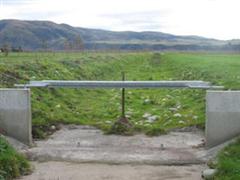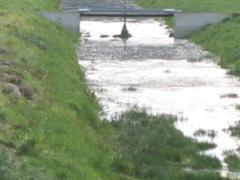How a Border Dyke works:

This is what an open irrigation gate looks like. As you can see the water is free to flow through the channel and onto the next section of the paddock.

A open gate with water running through.
Border Dykes are a permanent type of irrigation that are built into a slanting paddock. They work by a channel at the top of the slant, closing one gate inside it which means the water dams up, and flows over the edge of the channel into the paddock. In the paddock there are mounds of earth built up down the length of the paddock, which prevents the water running wild. When the strip between two mounds of earth has been covered with the water, the gate will open in the channel, and the water will flow to the next section of mounds preventing more water getting into the previously irrigated strip.
- Border Dykes have a clock (also called a sill) that times the rushing water, so when the farmer feels his paddock has had enough irrigation he can set the clock to close the gates.
- Wild Flood isn't used as much as Border Dykes, because it can wipe out fences and small plants easily when running.
- A Border Dyke doesn't work properly after working for a long time, so it will only stay flowing for a short time.
- If the dyke is too long it is not efficient, too much water will flow onto the land at the start of the dyke and little water will reach the land at the far end. Therefore you end up with an uneven irrigation pattern.
- Border Dykes can let out 620 litres of water per second onto a paddock.
© 2007 – Page created by: Alysha & Katelynn.


